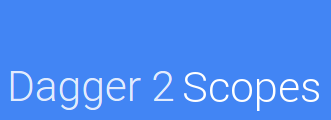Dagger2Scopes is a sample Android app to implement usual Dagger 1 multiple scoping logic with the brand new Dagger 2 Google lib. In this sample you will be able to find the following features:
- Multiple scopes with Dagger 2 (Components and subcomponents).
- An approach to Clean Architecture.
- An approach to MVP pattern.
Dependency Injection
Dagger 2 erases the dagger 1 graph concept by introducing the brand new components. The components available in this sample app are the following:
ApplicationComponent: This component will be used to expose application context and generic dependencies to components depending on this one or to child components. It will be used to injectDagger2ScopesAppand activities/fragments by component composition.AbstractActivityComponent: This one is used as an abstract activity scoped component and exposes activity context and common dependencies linked to activity lifecycle, likeNavigatororToolbarAnimator.GameListActivityComponent: ExtendsAbstractActivityComponentto provide game list related dependencies.GameDetailsActivityComponent: ExtendsAbstractActivityComponentto provide game details related dependencies.
All the activity scoped components are sharing the custom @ActivityScope.
Clean
This sample is modeled using the Uncle Bob's Clean Arquitecture approach. To reach the main goals of Clean, i am including the following modules:
- android: This one contains the ui graphics and platform implementations for some dependencies defined in the domain layer, like the
Navigator. Dependency injection is defined here too. - presentation (java): Presentation logic for the application is held here. It is the layer used to decouple the graphic view details from the model and the classes which work with it.
- domain (java): The business logic of the app. Here, you will also find the use cases (interactors), threading logic, and some boundaries defined by interfaces to implement in other modules, like the
Navigatoror theGameRepository. - repository (java): My implementation for the repository is defined here.
- datasources (java): Data source implementations.
Every dependency is provided by the dependency injection framework which maximizes the power of Inversion of Control principle. By this way, the dependencies always point from the outer layers to the inner ones. There aren't any inner layer classes depending on outer ones.
Every layer has his very own entity mapper to provide the inner layer inmediately next to it with the entity forms most adequated to it. This is done by that way to not violate de dependency rules. That is mentioned by Uncle Bob:
"...That would violate The Dependency Rule because it would force an inner circle to know something about an outer circle. So when we pass data across a boundary, it is always in the form that is most convenient for the inner circle."
Attributions
- Dagger 2 component and module structure based on Dagger 2 Google Samples.
- Project inspired by this blog entry from @android10.
- Clean arquitecture composition inspired by Clean-Contacts project by @PaNaVTEC.
Developed By
- Jorge Castillo Pérez - [email protected]

License
Copyright 2015 Jorge Castillo Pérez Licensed under the Apache License, Version 2.0 (the "License");
you may not use this file except in compliance with the License. You may obtain a copy of the License at
http://www.apache.org/licenses/LICENSE-2.0 Unless required by applicable law or agreed to in writing, software distributed under the License is distributed on an "AS IS" BASIS, WITHOUT WARRANTIES OR CONDITIONS OF ANY KIND, either express or implied. See the License for the specific language governing permissions and limitations under the License. 